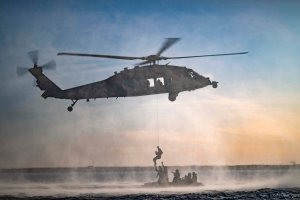
‘Airmen walk away from an explosive detonation during EPIC CRAB 25 Exercise at Northwest Field, Andersen Air Force Base, Guam, May 1, 2025. Air Force photo by Airman 1st Class Adasha Williams.
In the pantheon of great names for military exercises, few can rival “EPIC CRAB,” which pays tribute to the unique culture of the military’s explosive ordnance disposal, or EOD, community.
Led by U.S. Pacific Air Forces, this year’s exercise involved EOD technicians from the Air Force, Navy, Marine Corps, and the Republic of Singapore Air Force, said Air Force 1st Lt. Ariana Wilkinson, a spokeswoman for the 36th Wing on Guam.
As for why EPIC CRAB is named “EPIC CRAB,” well, the Air Force had a pretty detailed explanation.
“The name ‘CRAB’ is derived from the informal term for the Explosive Ordnance Disposal (EOD) badge, which is commonly referred to as a ‘crab’ due to its distinctive shape,” Wilkinson told Task & Purpose in an email. “This term is widely recognized within the EOD community. The EOD badge is unique in that it is the only badge awarded to service members from multiple Military Occupational Specialties (MOS) and Air Force Specialty Codes (AFSC) across the Department of Defense (DOD), as all EOD technicians attend the same joint training school.”
As for the “EPIC” portion? That’s a “play on ‘Expeditionary’ in the Pacific region, reflecting the exercise’s focus and location,” Wilkinson wrote.
And the exercise certainly was epic. A photo taken by the 36th Wing shows four airmen looking totally badass as they nonchalantly walk away from an explosion at Anderson Air Force Base on Guam. The picture could easily be mistaken for an album cover — cue “My Hero” by the Foo Fighters.
It turns out that “EPIC CRAB” is a variation of a theme. Last year, Navy EOD techs took part in the first King Crab Competition. The Navy’s Explosive Ordnance Disposal Group 2 also conducted Snow Crab Exercise 2025 this winter at Camp Ripley in Little Falls, Minnesota.
EPIC CRAB 25 was held from April 27 to May 3 on Guam, and it was coordinated by the 554th Rapid Engineer Deployable Heavy Operational Repair Squadron Engineers “Red Horse” Squadron, Wilkinson said.
The exercise took place on several locations across Guam to emphasize distributed operations and decentralized command and control, Wilkinson said. The EOD technicians divided into small teams and then used live explosives to neutralize unexploded ordnance and improvised explosive devices, Wilkinson said.
The scenarios took place both in the day and at night, so EOD techs used night vision goggles for nighttime exercises, she said.
Air Force EOD technicians must go through extensive training to learn how to deal with bombs, chemical weapons, and even nuclear threats, said Air Force spokesperson Laurel Falls
That training begins with the 26-day EOD Preliminary Course at Sheppard Air Force Base, Texas, which has a 53% attrition rate, Falls told Task & Purpose. The course is meant to test airmen’s physical and mental limits to prepare them to deal with explosives.
Airmen who make it through the preliminary course go on to the Naval School, Explosive Ordnance Disposal at Eglin Air Force Base, Florida, Falls said. The school trains service members from all military benches, and the program lasts 143 days.
Following the school, airmen go to their first duty station where they go through 18 more months of advanced training on the 10 core missions that Air Force EOD technicians support, including countering improvised explosive devices, responding to weapons of mass destruction, handling nuclear weapons incidents, recovering unexploded ordnance, clearing operational ranges, and engaging in irregular warfare, Falls said.
The latest on Task & Purpose
- Army to eliminate 2 Security Force Assistance Brigades, reassign experienced soldiers
- Why the Army’s new XM7 rifle reignited a debate over volume of fire
- Air Force delay on separation and retirement orders isn’t ‘stop loss,’ defense official says
- F-35’s close call over Yemen raises questions about how it’s used
- An Army unit’s ‘extreme use of profanity’ was so bad, they made a rule about it

